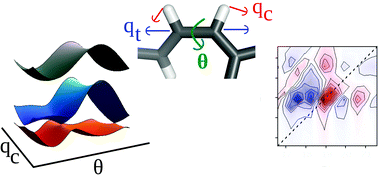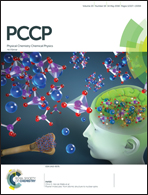The origin of absorptive features in the two-dimensional electronic spectra of rhodopsin†
Abstract
In rhodopsin, the absorption of a photon causes the isomerization of the 11-cis isomer of the retinal chromophore to its all-trans isomer. This isomerization is known to occur through a conical intersection (CI) and the internal conversion through the CI is known to be vibrationally coherent. Recently measured two-dimensional electronic spectra (2DES) showed dramatic absorptive spectral features at early waiting times associated with the transition through the CI. The common two-state two-mode model Hamiltonian was unable to elucidate the origin of these features. To rationalize the source of these features, we employ a three-state three-mode model Hamiltonian where the hydrogen out-of plane (HOOP) mode and a higher-lying electronic state are included. The 2DES of the retinal chromophore in rhodopsin are calculated and compared with the experiment. Our analysis shows that the source of the observed features in the measured 2DES is the excited state absorption to a higher-lying electronic state and not the HOOP mode.



 Please wait while we load your content...
Please wait while we load your content...